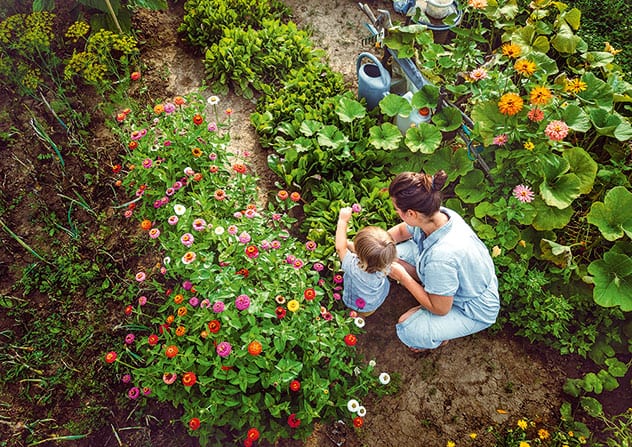Once thought of as just a pastime for retirees, gardening is becoming increasingly popular with people of all ages. But it’s not just the hobby’s health and therapeutic benefits that are winning people over. Many green thumbs have also embraced the chance to grow their own food – and ‘edible gardens’ are now popping up all over Australia and New Zealand.
Naomi Lacey, Darwin-based permaculturalist and President of the Australian City Farms and Community Gardens Network, says community gardening in particular has grown in leaps and bounds in recent years, in part due to a trend away from buying supermarket produce. “People are thinking more about where their food comes from, and how it’s produced, and therefore wanting to know how they can do it better themselves,” says Lacey. “In some respects, it feels like we’re trending all the way back to the post war years, when everyone had a veggie patch and a chicken pen in their backyard…I think it’s wonderful to see.”
The Network, founded in 1996, supports and advocates for community gardens all across Australia. They currently list 650 community gardens in their online directory, but Lacey predicts this is only the tip of the iceberg. “We think that [650 gardens] is probably only around one-quarter to one-third of the actual gardens in Australia,” says Lacey. “They’re everywhere now, and they’re coming up in all different ways… [For example] we’re hearing about community gardens in little gated complexes, where there might be thirty townhouses with some communal space, and they’re building community gardens… And the same in public housing.”
Public housing estates in Melbourne provide one such example. Through the Public Housing Community Garden program, funded by the Department of Health and Human Services, residents are supported in establishing and growing their own community gardens, providing a valuable avenue for social connection and local food production.
Growing communities
Melbourne-based non-profit, Cultivating Community, has been running the program since 2002. “We currently support over 700 individuals and families in growing their own food,” says Daniyela Rob, CEO of Cultivating Community. “Across the program there’s thirty-two different languages spoken, which gives an idea of the diversity of the people growing food, and the food that’s grown.”
As well as managing the 21 community gardens across the program, the organisation also facilities a School Food Garden Program and a range of Community Food Projects, based at the Atherton Public Housing Estate in Fitzroy. Such projects include an after-school cooking program, a weekly ‘meet and eat’, and a monthly baking group, where members of the community gather together to make sourdough bread in an outdoor wood-fired oven, a process that’s undertaken over a two-day period. Rob describes this shared cultural experience as a beautiful process. “People come in and say, ‘oh, you’re making sourdough. This is the bread we make in our culture.’ It’s been really lovely.”
And, with the average age of the gardeners sitting at 62, the community gardens and associated initiatives also provide valuable social interaction for residents who may otherwise feel isolated. “Some of our older residents might not be seeing their kids or grandkids as much as they’d want to,” says Rob. “[Through the gardens], residents are making connections with other people that they wouldn’t have had otherwise, even though they were living on the same estate.”
Not only do community gardens foster valuable social connections, they also provide participants with greater confidence in gardening, and other important life skills.
Ena Velseboer, manager of Good Neighbour Community Gardens in New Zealand’s north island, says people often lack confidence in their gardening ability. “Too often people believe they are not good at gardening,” says Velseboer, a life-long vegetable gardener. “Just as a garden needs to be nurtured, so do people…Growing individuals through gardening gives me a real burn in my belly.”
Good Neighbour Community Gardens represents one facet of the Good Neighbour Aotearoa Trust, a charitable non-profit community organisation established in 2013. With the motto of ‘growing souls through soil’ the Community Gardens arm runs community gardens in Bethlehem and Welcome Bay. Their model comprises garden beds available for individuals and families to rent on an annual basis, as well as communal vegetable garden beds, where food for the community is grown. Together the gardens bring together 141 members and volunteers each week, with plans to expand to other areas within the Bay of Plenty in coming years.
Velseboer says the best sign of success is when members gain the confidence and skills to transition from the community gardens to their own space, establishing vegetable gardens within their homes. Supported through this process by Good Neighbour, Velseboer says these members often come back to the community gardens as volunteers. “They miss the closeness, fun and learning that happens when we all get together,” says Velseboer. “The friendships, support, learnings are the foundations upon which each day is built. There is never no laughter.”
So much to learn
Developing lifelong skills is also the focus of New Zealand-based charity, Garden to Table. Established in 2008, this curriculum-integrated gardening and cooking programme currently runs across 200 New Zealand primary schools, providing 15,000 students with valuable real-world learning opportunities.
“Garden to Table is a holistic programme that has positive long-term health, education, environmental and social outcomes for our children,” says Linda Taylor, Executive Officer of the Garden to Table Trust. “It’s also a great way to engage children in learning.”
Taylor says the Garden to Table programme involves classes spending time in the school’s vegetable garden and cooking area. By engaging with the whole ‘garden to plate’ process – growing their own produce then preparing, cooking and eating it – students learn where their food comes from.
Feedback from the initiative has been overwhelmingly positive. “We have had reports from schools that they have their lowest absentee rates on Garden to Table days, as the children love the programme and don’t want to miss out,” says Taylor.
Still, gardens don’t only provide a valuable learning experience. There could also be some serious economic benefits to small-scale edible gardens.
Dr Georgia Csortan, a researcher in urban food production at the University of South Australia, recently conducted a study into the cost of – and return from – productive home and community gardens. With a focus hard data and measurements, it was the first study of its nature in the world.
“When I started looking into it, I found there had been quite a lot written in terms of social impact and connections,” explains Csortan, “but not much on the time it takes, and how much it costs people… [and] almost nothing about how much water it takes.”
Comprising an initial survey of home gardeners, volunteers collected data on how much food they produced, the costs incurred, their water usage, and the time they spent on gardening-related activities.
Analysing the information, Csortan found the economics pleasantly surprising. “If you don’t consider the setup costs, almost 80 per cent of our gardeners were set to save more than $250 per year on their grocery bills,” she explains. “If you do consider the setup costs, then 65 per cent of our gardens involved were going to break even in five years or less. We found that quite amazing…When you think of a garden, five years is nothing.”
Csortan also has good news for small-scale gardeners. “[We found] as the area under production increased, people were putting in less money, less time and less water per square metre… but they [also] grew less food per square metre, and the retail value was lower. That was exciting for small gardens,” Csortan explains, “[because] you can have a small space, yet still be really productive.”
Considering this, Lacey encourages everyone to grow their own food – even if you have to start small. “Whether it’s a pot of herbs on your windowsill … or 10 garden beds in your backyard and a couple of chickens, anything you can do towards producing food locally will help ease the climate crisis we are in now,” she says.
Where to start?
Adelaide-based horticulturalist, Karen Montgomery, provides the following tips for establishing an edible garden:
- Location: Choose a sunny spot, sheltered from the wind. (Wind dehydrates plants faster than the sun does!)
- Watering: Ensure watering is consistent. In the early stages of growing plants from seed, seeds must stay moist – if they dry out, they die. Consider installing an irrigation system to make the process more consistent during the week, if necessary.
- Soil: Focus on keeping your soil healthy and happy. Feed your soil with manure, and ensure it doesn’t dry out. (The healthier the soil, the less likely you’ll need pest control.)







